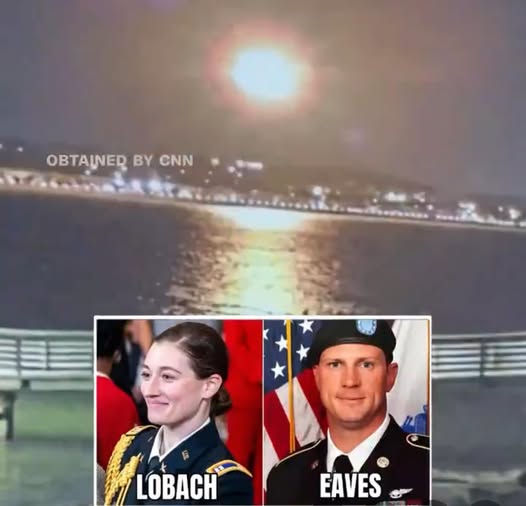Pilot Error Cited in Deadly D.C. Mid-Air Collision: New Report Reveals Black Hawk Crew Ignored Course Change Instructions
WASHINGTON, D.C. — A newly published report has shed devastating new light on the January mid-air collision over Washington, D.C., between a military Black Hawk helicopter and a commercial passenger airplane — a tragedy that claimed the lives of 67 people and stunned the nation.
According to an investigation detailed in The New York Times on Sunday, the pilot of the Black Hawk helicopter, Capt. Rebecca Lobach, ignored air traffic control instructions to alter her course just seconds before the fatal crash. Instead, Lobach and her co-pilot, Chief Warrant Officer 2 Andrew Loyd Eaves, chose to rely on “visual separation,” a riskier form of airspace navigation that ultimately ended in disaster.
Routine Training Turns Into Catastrophe
The day of the accident was intended to be routine. Capt. Lobach was undergoing her annual flight evaluation — a standard practice meant to ensure pilots maintain proficiency in handling aircraft under various conditions. Eaves, an experienced flight instructor, was accompanying her during the exercise.
As the helicopter maneuvered through the controlled airspace above Washington, D.C., air traffic controllers informed the Black Hawk crew of a nearby passenger airliner. The commercial aircraft, operating a scheduled regional flight with dozens of passengers on board, was ascending through the same sector of airspace the Black Hawk was navigating.
Controllers issued a clear directive to Lobach to alter her flight path to avoid any potential conflict. However, the new report reveals that Lobach and Eaves acknowledged the advisory but declined to change course under formal control. Instead, they requested and proceeded under “visual separation” — a common but risky aviation practice that allows pilots to maintain safe distances from other aircraft based on their own sight rather than by strict controller guidance.
A Deadly Miscalculation
In theory, visual separation can be a safe and effective way for skilled pilots to navigate busy airspace. However, it heavily depends on perfect visibility, accurate distance judgment, and mutual awareness between aircraft — any failure in these areas can have catastrophic consequences.
According to the report, seconds after confirming they would maintain visual separation, the Black Hawk collided with the ascending passenger plane. The violent impact sent both aircraft plummeting into a crowded suburban neighborhood just outside downtown Washington, resulting in widespread destruction on the ground as well.
All 67 people aboard the airliner — including passengers, crew members, and both pilots — perished, along with the Black Hawk crew. Miraculously, no fatalities were reported among civilians on the ground, although several were injured, and multiple homes were damaged or destroyed.
Analysis of Critical Mistakes
Aviation experts cited in the New York Times report point to several critical errors in the moments leading up to the crash:
-
Overreliance on Visual Separation: Despite clear warnings from air traffic control, Lobach and Eaves trusted their own visual assessments in a high-traffic, complicated airspace environment where even slight misjudgments can be fatal.
-
Underestimating Traffic Speed and Altitude: Reports suggest the Black Hawk crew may have underestimated how quickly the passenger aircraft was climbing and closing the distance between them.
-
Communication Gaps: While air traffic controllers issued standard instructions, there was no follow-up or escalation after the Black Hawk opted for visual separation — a step that, some experts argue, might have prevented the collision if pursued more aggressively.
-
Training Environment Pressure: Some analysts also speculate that the training and evaluation setting may have contributed to riskier decision-making, with Capt. Lobach potentially seeking to demonstrate proficiency under less guidance.
Fallout and Investigations
The incident has prompted a wave of investigations and public scrutiny, both of military aviation protocols and the broader air traffic control systems in place over heavily trafficked metropolitan areas like Washington, D.C.
The U.S. Army has launched its own inquiry into the policies that allowed the Black Hawk crew to choose visual separation in such congested airspace, while federal aviation authorities are reviewing procedural safeguards to prevent a recurrence of such a disaster.
Meanwhile, families of the victims are demanding answers and accountability, questioning why a preventable mid-air collision was allowed to occur over one of the nation’s most carefully monitored skies.
“This was not an accident — it was a chain of avoidable errors,” said one family member during a press conference. “Sixty-seven lives lost because critical decisions were made without enough caution.”
Remembering the Victims
Across the country, memorials have been held to honor the lives lost in the collision. Tributes poured in not just for the passengers and airline crew, but also for Capt. Lobach and Chief Warrant Officer Eaves — recognizing the dangers inherent in military aviation service even as painful questions are raised about the choices made that day.
“Rebecca and Andrew served their country with distinction,” said a statement from the Department of Defense. “Their loss, along with that of every soul aboard that plane, is a tragedy beyond words. We are committed to ensuring their memories drive improvements in aviation safety.”
A Nation Grapples With the Aftermath
As investigations continue, the January crash remains a grim reminder of the risks involved in managing complex airspace, the critical importance of following controller guidance, and the tragic consequences when systems of safety break down.
More details are expected to emerge in the coming weeks as federal investigators complete their final reports, but the nation is already left with a hard truth: in aviation, seconds and decisions can mean the difference between life and death.
